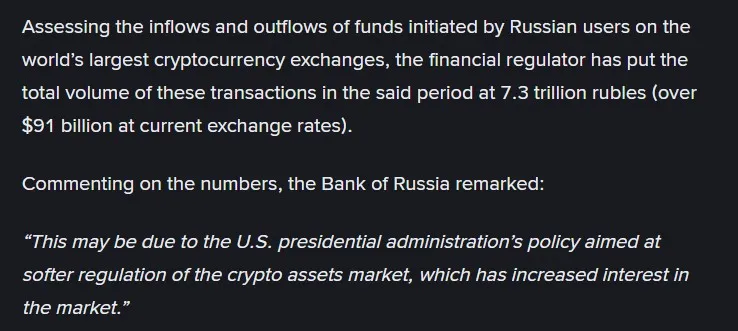
What if we told you Russia has just moved over $91 billion worth of crypto—but many of its citizens can’t even legally buy Bitcoin?
Confusing, right? That’s just what’s happening.
The Bank of Russia just announced a massive increase in crypto-related transactions—but before you get your hopes up that crypto is finally going mainstream, here's the catch: this money is flowing mainly through restricted financial products, not actual coins that people can hold, or spend.
So what’s really going on? And does this have anything to do with the Bitcoin price we’re all watching? Let’s break it down.
The Bank recently shared a big number: over $91 billion worth of crypto-linked transactions were made by Russians in recent months, according to Binance data.

Source: Binance
This spike made headlines in the latest cryptocurrency news today—and it got the global crowd talking. But here’s the real question: Is this a sign of real adoption, or just controlled access for a select few?
Even though the number is big, it doesn’t mean everyone in this country is suddenly buying Bitcoin or trading altcoins. In fact, most people can’t.
According to a report from Wu Blockchain, the Bank of Russia crypto policy is only allowing licensed financial institutions to offer crypto-linked products like derivatives, securities, and digital financial assets.

Source: Wu Blockhain
But there’s a twist: these are non-deliverable products. That means investors won’t actually get coins in their wallets—they only get financial exposure to the price movements.
So, is it real if there’s no Bitcoin or Ethereum involved? Or is it just another financial layer for the privileged?
Here’s where it gets even more interesting. T-Bank (formerly Tinkoff Bank) has become the first financial institution in this country to launch these government-approved cryptocurrency tools.

Source: T-Bank X
They’re offering investment products based on platforms like Atomyze, which track prices. But again, regular people can’t use them. Only qualified, high-net-worth investors have access to these services.
So we’re looking at a system that says, “Yes, you can invest in crypto—but only if you already have money and permission.” Does that count as real adoption? This action marks a big shift in the Russia crypto regulation landscape, especially Russia allowing cryptocurrecny products in a limited way.
As of today, Bitcoin price is trading around $108,800, with just a 0.01% gain in the last 24 hours. Why so flat?
Because maybe no one’s actually buying or selling real BTC through these products. Since they’re non-deliverable, there’s no impact on the Bank of Russia Bitcoin narrative or its supply or demand. That’s why the price hasn’t moved much.
In this latest Russia crypto news, while banks and elite investors get new asset options, ordinary Russians are facing tighter restrictions. The government is cracking down on peer-to-peer trading, Telegram-based deals, and unofficial wallet activity. They’re even building tools to track suspicious movements and block what they call “droppers.”
Russia rising crypto volume, and this new asset adoption strategy looks like progress—but only if you read the headlines. The reality is more complicated. There’s growth, yes, but it’s limited, supervised, and far from open adoption.
Still, the fact that a major economy is embracing crypto products, even in a closed-loop format, is a signal that this financial market isn’t going away. It’s evolving—and the rest of the world is watching closely.

Sara Sethiya is an experienced crypto journalist with five years of experience in blockchain research, price movements, and market analysis. With a background in mass communication and journalism, she specializes in data-driven news articles, in-depth market reports, and SEO-optimized content. As a team lead and content writer at CoinGabbar, she examines on-chain metrics, evaluates liquidity trends, and analyzes tokenomics to uncover market patterns. Her analytical approach helps traders and investors interpret market shifts, identify potential opportunities, and understand the broader impact of blockchain innovations on the financial ecosystem.